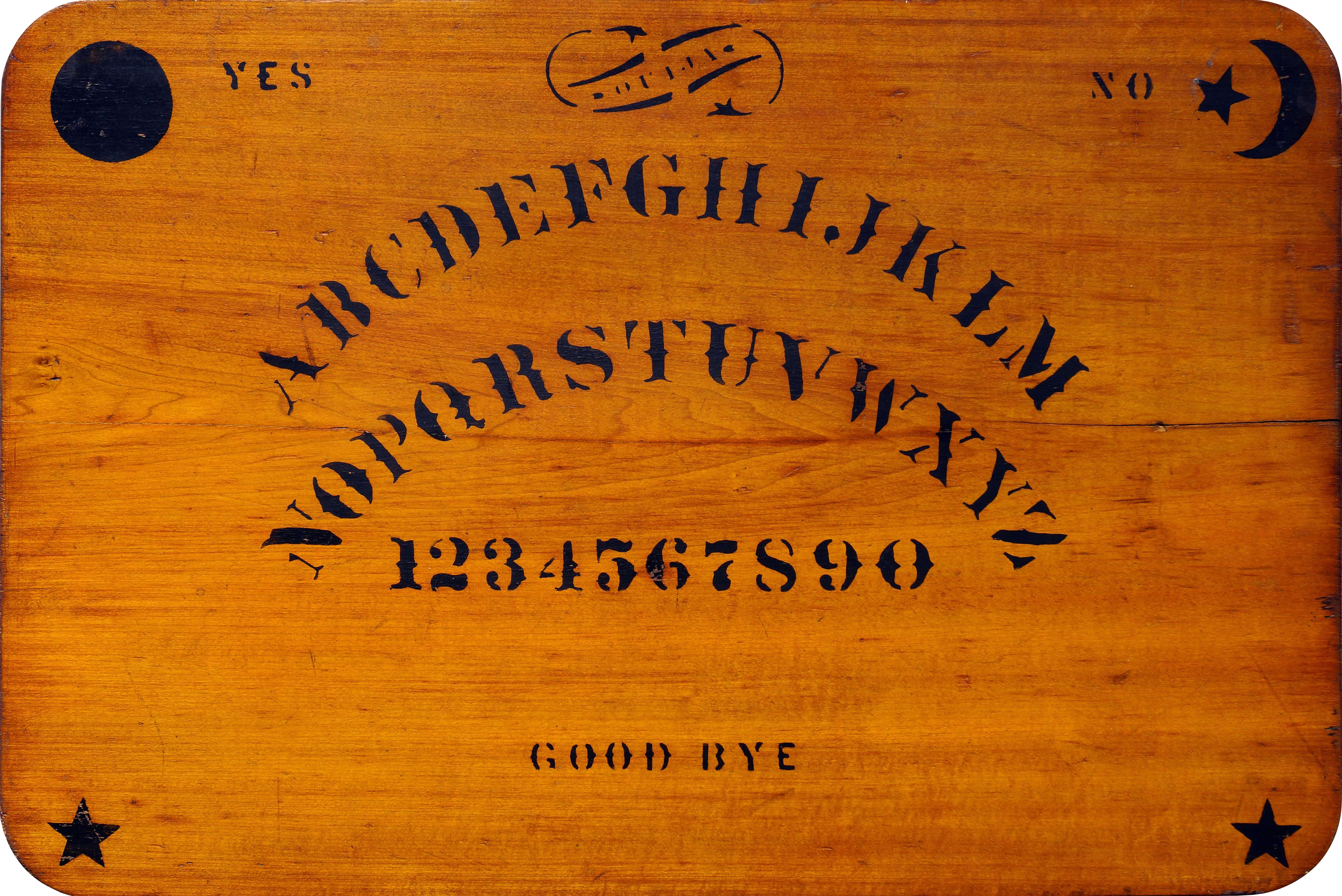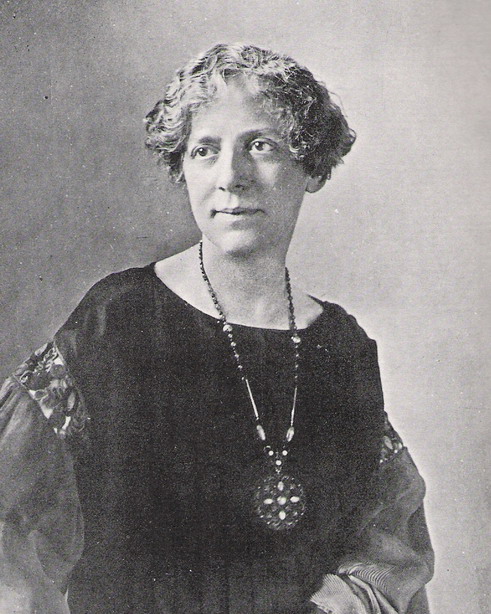|
Ouija
The Ouija ( , ), also known as a Ouija board, spirit board, talking board, or witch board, is a flat board marked with the letters of the Latin alphabet, the numbers 0–9, the words "yes", "no", and occasionally "hello" and "goodbye", along with various symbols and graphics. It uses a planchette (a small heart-shaped piece of wood or plastic) as a movable indicator to spell out messages during a séance. Participants place their fingers on the planchette, and it is moved about the board to spell out words. The name "Ouija" is a trademark of Hasbro (inherited from Parker Brothers), but is often used generically to refer to any talking board. Spiritualists in the United States believed that the dead were able to contact the living, and reportedly used a talking board very similar to the modern Ouija board at their camps in Ohio during 1886 with the intent of enabling faster communication with spirits. Following its commercial patent by businessman Elijah Bond being passed o ... [...More Info...] [...Related Items...] OR: [Wikipedia] [Google] [Baidu] |
Helen Peters Nosworthy
Helen Augusta Peters Nosworthy (September 19, 1851 – November 8, 1940) was an American spiritualist and medium who named and helped patent the ouija board and is now known as the Mother of the Ouija Board. Early life Helen Peters was born in 1851 in Baltimore, Maryland. Her affluent family was part of Southern society had many ties to the Confederate Army during the American Civil War. Helen and her siblings would often take buttons from dead soldiers after battles. Ouija Board The spiritualist movement began in the United States around the time of Nosworthy's birth. The movement gained further popularity following American Civil War. Mediums did significant business in allegedly allowing survivors to contact lost relatives. Living in Baltimore, Nosworthy became a medium and spiritualist herself. Her sister, Mary, had married Elijah Bond who had invented a talking board with his business partner, Charles W. Kennard. Nosworthy became a stockholder in the Kennard Novelty Compa ... [...More Info...] [...Related Items...] OR: [Wikipedia] [Google] [Baidu] |
Elijah Bond
Elijah Jefferson Bond (January 23, 1847 – April 14, 1921) was an American lawyer and inventor. He is best known for patenting the ouija board. Early life Elijah Jefferson Bond was born on January 23, 1847, in Bel Air, Maryland, to Charlotte Howard (née Richardson) and William B. Bond. His father was a judge. Bond graduated from the University of Maryland School of Law. Career Bond served in the Confederate States Army during the American Civil War. He worked as a lawyer in Baltimore until around 1918. Inventions Although he invented and patented items, including a steam boiler, he is best remembered for patenting what became known as the Ouija board. He filed for a United States The United States of America (USA), also known as the United States (U.S.) or America, is a country primarily located in North America. It is a federal republic of 50 U.S. state, states and a federal capital district, Washington, D.C. The 48 ... patent on May 28, 1890. Charles W. Kennard ... [...More Info...] [...Related Items...] OR: [Wikipedia] [Google] [Baidu] |
Planchette
A planchette ( or ), from the French for "little Plank (wood), plank", is a small, usually heart-shaped flat piece of wood equipped with two wheeled casters and a pencil-holding aperture pointing downwards, used to facilitate automatic writing. The use of planchettes to produce mysterious written messages gave rise to the belief that the devices foster communication with spirits as a form of mediumship. The devices were popular in séances during the Victorian era, before their eventual evolution into the simpler, non-writing pointing devices for ouija boards that eclipsed the popularity of their original form. Scientists explain the motion is due to the ideomotor effect, but paranormal advocates believe the planchette is moved by the presence of spirits or some form of subtle energy. Planchettes took on a variety of forms during the height of their popularity. American planchettes were traditionally heart- or shield-shaped, but manufacturers produced a wide range of shapes ... [...More Info...] [...Related Items...] OR: [Wikipedia] [Google] [Baidu] |
Séance
A séance or seance (; ) is an attempt to communicate with spirits. The word ''séance'' comes from the French language, French word for "session", from the Old French , "to sit". In French, the word's meaning is quite general and mundane: one may, for example, speak of "" (). In English, however, the word came to be used specifically for a meeting of people who are gathered to receive messages from ghosts or to listen to a mediumship, spirit medium discourse with or relay messages from spirits. In modern English usage, participants need not be seated while engaged in a séance. Fictionalised conversations between the deceased appeared in ''Dialogues of the Dead'' by George Lyttelton, 1st Baron Lyttelton, George, First Baron Lyttelton, published in England in 1760. Among the notable spirits quoted in this volume are Peter the Great, Pericles, a "North-American Savage", William Penn, and Christina, Queen of Sweden. The popularity of séances grew dramatically with the founding of t ... [...More Info...] [...Related Items...] OR: [Wikipedia] [Google] [Baidu] |
Ideomotor Effect
The ideomotor phenomenon is a psychological phenomenon wherein a subject makes motions unconsciously. Also called ideomotor response (or ideomotor reflex) and abbreviated to IMR, it is a concept in hypnosis and psychological research. It is derived from the terms "ideo" (idea, or mental representation) and "motor" (muscular action). The phrase is most commonly used in reference to the process whereby a thought or mental image brings about a seemingly "reflexive" or automatic muscular reaction, often of minuscule degree, and potentially outside of the awareness of the subject. As in responses to pain, the body sometimes reacts reflexively with an ideomotor effect to ideas alone without the person consciously deciding to take action. The effects of automatic writing, dowsing, facilitated communication, applied kinesiology, and ouija boards have been attributed to the phenomenon. The associated term "ideo-''dynamic'' response" (or "reflex") applies to a wider domain, and extends t ... [...More Info...] [...Related Items...] OR: [Wikipedia] [Google] [Baidu] |
Automatic Writing
Automatic writing, also called psychography, is a claimed psychic ability allowing a person to produce written words without consciously writing. Practitioners engage in automatic writing by holding a writing instrument and allowing alleged spirits to manipulate the practitioner's hand. The instrument may be a standard writing instrument, or it may be one specially designed for automatic writing, such as a planchette or a ouija board. Religious and spiritual traditions have incorporated automatic writing, including Fuji in Chinese folk religion and the Enochian language associated with Enochian magic. In the modern era, it is associated with Spiritualism and the occult, with notable practitioners including W. B. Yeats and Arthur Conan Doyle. There is no evidence supporting the existence of automatic writing, and claims associated with it are unfalsifiable. Documented examples are considered to be the result of the ideomotor phenomenon. History Early history Spirit ... [...More Info...] [...Related Items...] OR: [Wikipedia] [Google] [Baidu] |
Pearl Curran
Patience Worth was allegedly a disembodied spirit contacted by Pearl Lenore Curran (February 15, 1883 – December 2, 1937). This purported relationship produced several novels, poetry and prose which Pearl Curran claimed were delivered to her through channelling the spirit of Patience Worth. Psychologists and skeptics who have studied Curran's writings are in agreement that Patience was a fictitious creation of Curran."Patience Worth" ''''. Retrieved 2015-05-30. About Pearl Curran Curran was born Pearl Lenore Pollard in |
Catholicism
The Catholic Church (), also known as the Roman Catholic Church, is the List of Christian denominations by number of members, largest Christian church, with 1.27 to 1.41 billion baptized Catholics Catholic Church by country, worldwide as of 2025. It is among the world's oldest and largest international institutions and has played a prominent role in the history and development of Western civilization.Gerald O'Collins, O'Collins, p. v (preface). The church consists of 24 Catholic particular churches and liturgical rites#Churches, ''sui iuris'' (autonomous) churches, including the Latin Church and 23 Eastern Catholic Churches, which comprise almost 3,500 dioceses and Eparchy, eparchies List of Catholic dioceses (structured view), around the world, each overseen by one or more Bishops in the Catholic Church, bishops. The pope, who is the bishop of Rome, is the Papal supremacy, chief pastor of the church. The core beliefs of Catholicism are found in the Nicene Creed. The ... [...More Info...] [...Related Items...] OR: [Wikipedia] [Google] [Baidu] |
Theistic Satanism
Theistic Satanism, otherwise referred to as traditional Satanism, spiritual Satanism, or religious Satanism, is an umbrella term for religious groups that consider Satan to objectively exist as a deity, supernatural entity, or spiritual being worthy of worship or reverence, whom individuals may believe in, contact, and convene with, in contrast to the atheistic archetype, metaphor, or symbol found in LaVeyan Satanism. Organizations who uphold theistic Satanist beliefs most often have few adherents, are loosely affiliated or constitute themselves as independent groups and cabals, which have largely self-marginalized. Another prominent characteristic of theistic Satanism is the use of various types of magic. Most theistic Satanist groups exist in relatively new models and ideologies, many of which are independent of the Abrahamic religions. In addition to the worship of Satan or the Devil in the Abrahamic sense, religious traditions based on the worship of other "adversarial ... [...More Info...] [...Related Items...] OR: [Wikipedia] [Google] [Baidu] |
Group Of Model Figures Showing A Worshipper
A group is a number of persons or things that are located, gathered, or classed together. Groups of people * Cultural group, a group whose members share the same cultural identity * Ethnic group, a group whose members share the same ethnic identity * Religious group (other), a group whose members share the same religious identity * Social group, a group whose members share the same social identity * Tribal group, a group whose members share the same tribal identity * Organization, an entity that has a collective goal and is linked to an external environment * Peer group, an entity of three or more people with similar age, ability, experience, and interest * Class (education), a group of people which attends a specific course or lesson at an educational institution Social science * In-group and out-group * Primary, secondary, and reference groups * Social group * Collectives Philosophy and religion * Khandha, a Buddhist concept of five material and mental factors ... [...More Info...] [...Related Items...] OR: [Wikipedia] [Google] [Baidu] |
Demonic Possession
Spirit Possession is an altered state of consciousness and associated behaviors which are purportedly caused by the control of a human body and its functions by Supernatural#Spirit, spirits, ghosts, demons, angels, or Deity, gods. The concept of spirit possession exists in many cultures and religions, including Buddhism, Hinduism, Islam, Christianity,Mark 5:9, Luke 8:30 Judaism, Wicca, Haitian Vodou, Dominican Vudú, and Southeast Asian, African, and Indigenous peoples of the Americas, Native American traditions. Depending on the cultural context in which it is found, possession may be thought of as voluntary or involuntary and may be considered to have beneficial or detrimental effects on the host. The experience of spirit possession sometimes serves as evidence in support of belief in the existence of spirits, deities or demons. In a 1969 study funded by the National Institute of Mental Health, spirit-possession beliefs were found to exist in 74% of a sample of 488 societies i ... [...More Info...] [...Related Items...] OR: [Wikipedia] [Google] [Baidu] |






